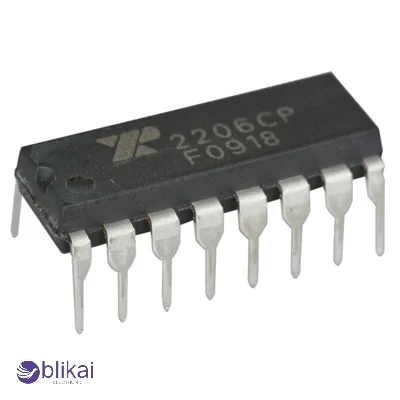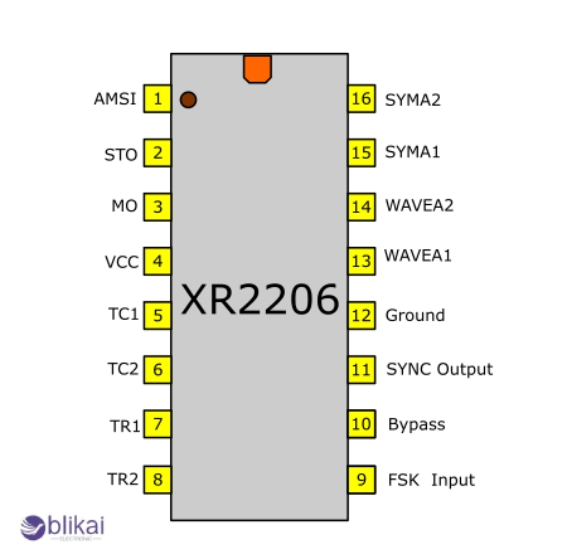XR2206 Function Generator IC: Pinout, Specs & Applications
Introduction to XR2206
The XR2206, a vintage monolithic function generator IC, is applied in generating high-quality analog waveforms. This is a chip that is a tri-function generator with a variety of frequencies designed by the Exar Corporation that can produce due to its programmable option sine, square and triangle waves. It is commonly used in test equipment, waveform generators and in modulation systems and in do-it-yourself electronics. Although newer digital options exist, the XR2206 is regularly used to test analog signals because it is simple and reliable.

XR2206 IC Pinout and Configuration
XR2206 is normally packed in a 16-pin dual-in-line package (DIP). It is important to know its pinout in order to set it up to deliver a number of waveforms. That is a pin-by-pin summary:

The frequency can easily be controlled by external resistors (and capacitors) connected to pins 1 and 2. Pins 6, 8 and 9 offer various waveforms.
Technical Specifications of XR2206
The XR2206 is built for analog waveform generation with high accuracy and low distortion. Here are its most important electrical characteristics:
| Parameter | Specification |
| ---------------------- | ---------------------------------- |
| Supply Voltage Range | 10V to 26V |
| Output Waveforms | Sine, Triangle, Square |
| Frequency Range | 0.01 Hz to 1 MHz |
| Frequency Stability | Typically 0.005%/°C |
| Output Amplitude | Up to 3V peak-to-peak (adjustable) |
| Sine Wave Distortion | < 1% (after shaping) |
| Modulation Capability | AM and FM via external control |
| Typical Operating Temp | 0°C to +70°C |
| Package Type | 16-pin DIP or SOIC |
The frequency can easily be controlled by external resistors (and capacitors) connected to pins 1 and 2. Pins 6, 8 and 9 offer various waveforms.
How to Use XR2206 in Function Generator Circuits
The XR2206 monolithic function generator IC allows generating high-quality analog signals and waveforms like sine, triangle, and square waves. It can be constructed using only a small number of passive elements, and so it is an expedient and convenient signal generator design. The following is a way you can use the XR2206 in a realistic circuit.
Basic Circuit Configuration
The XR2206 has an external timing capacitor (CT) and resistor ( RT) to produce a desired frequency. These things relate to:
- Pin 1 (CT): Connect a timing capacitor between this pin and ground.
- Pin 2 (RT): Connect a resistor from this pin to ground.
The timing components directly control the oscillator's frequency. Smaller values of RT and CT result in higher frequencies. For example, with RT = 10 kΩ and CT = 1 nF, you get approximately 100 kHz output.
Pin 3 is optional and accepts a control voltage for frequency modulation (FM). Applying a variable voltage here allows voltage-controlled frequency sweeping, which is ideal for testing or tone generation.
Output Pins:
- Pin 6: Sine wave output
- Pin 8: Triangle wave output
- Pin 9: Square wave output (through an internal comparator)
Each of these waveforms can be used independently or simultaneously, depending on the circuit's requirements.
Frequency Formula
The frequency of oscillation is approximately:
f = \frac{1}{RT \times CT}
It is a simplified model. In reality, even the internal strength of the current source and the supply voltage determine the frequency of emission. The exact tuning should always be done using a datasheet or by initialing your circuit on a breadboard.
- RT in ohms (Ω)
- CT in farads (F)
- f in hertz (Hz)
In the case of proper designs, the product of RT and CT should be within the recommended range, usually providing an output frequency range less than 1 Hz to approximately 1 MHz.
Amplitude Control
The output waveform amplitude depends on the power supply voltage and may be adjusted using an external potentiometer or a voltage divider at the output pins. Alternatively, to provide more consistent control of the amplitude, particularly when driving other stages, it may be worth using an op-amp stage to buffer the output.
Waveform Shaping
The capability to generate low-distortion sine waves is one of the bright characteristics of the XR2206. In order to attain this:
- Connect a trimming potentiometer (typically 10 kΩ) to Pin 5.
- Adjust the potentiometer to minimize harmonic distortion in the sine output at Pin 6.
This waveform shaping control adjusts the internal symmetry of the signal, improving waveform quality, especially in mid-frequency ranges.
Additional Tips
- Use decoupling capacitors (e.g., 0.1 µF and 10 µF) near the power supply pins to stabilize performance.
- For frequency sweeping applications, apply a triangular or ramp waveform to Pin 3 to perform a linear frequency sweep.
- Load the outputs properly (e.g., 1kΩ to 10kΩ) to avoid waveform clipping or distortion.
Applications of the XR2206 IC
The XR2206 is used in a variety of analog and mixed-signal applications:
1. Function Signal Generators
The XR2206 is most typical in the construction of sine, square, and triangle wave generation function generators. It has adjustable frequency and amplitude, and this makes it an essential part of an analog test system. Such generators are commonly applied to analysing amplifiers, filters and other analog circuits in laboratory environments and during development.
2. Audio Signal Generators
The XR2206 has a frequency of operation of 20Hz to 20kHz, which makes it compatible with an audio testing application. In order to test sound systems, speakers and amplifiers, it can produce low-distortion tones. It is easily and readily tuned in frequency, making it suitable for the calibration of audio products, such as in the creation of test tones used to calibrate audio systems.
3. Frequency Sweep Generators
Due to the voltage-controlled frequency input, the XR2206 may be arranged to act as a frequency sweep generator. This can be applied in the evaluation of the frequency response of filters, resonant circuits or antennas. Its sweep capability, which allows a user to change the output frequency automatically with time, makes it a good choice when characterizing system bandwidth.
4. Tone Generators and Sound Effects
The XR2206 finds application in electronic toys, alarms, chimes and music devices to generate a range of tones or sound effects. It can play interesting sound signals or realistic warning tones by controlling the waveform or frequency. This is what makes it popular among hobbyists to carry out audio-related DIY projects.
5. Educational and Hobby Projects
Because of its ease of use and variety of uses, the XR2206 is often sold as part of an education kit and in hobbyist circuit boards. It allows learners and amateurs to know how the generation of waveforms, signal modulation and frequency control are performed. It is also versatile, which is why it allows building your custom lab tools, DIY Function generators, and others.
XR2206 vs Other Function Generator ICs
Here’s a comparison of XR2206 with other well-known function generator ICs:
|
Feature |
XR2206 |
ICL8038 |
MAX038 |
AD9833 |
|
Output Waveforms |
Sine, Triangle, Square |
Sine, Triangle, Square |
Sine, Triangle, Square |
Sine, Triangle, Square |
|
Frequency Range |
0.01 Hz – 1 MHz |
0.001 Hz – 300 kHz |
Up to 20 MHz |
Up to 12.5 MHz |
|
Supply Voltage |
10 – 26V |
10 – 30V |
5 – 15V |
2.3 – 5.5V |
|
Control Type |
Analog |
Analog |
Analog |
Digital (SPI) |
|
Best For |
Analog waveform generation |
Low-cost analog signal gen |
High-performance lab gear |
Digital systems, Arduino |
The XR2206 stands out for its cost-efficiency and ease of use, but modern digital ICs like the AD9833 offer higher frequency and microcontroller integration for advanced applications.
Conclusion
XR2206 is a capable and solid analog waveform generator solution IC. Since it supports sine, triangle, and square waves out over a large frequency range, it continues to be an engineer, teacher, and hobbyist favorite. The XR2206 is a small dual op-amp with some big possibilities; appropriate when placed in test benches, tone generators, or sweep circuits.
L78L05ABUTR Regulator: Features, Applications and Datasheet
10k Resistor Color Code: Everything You Need to Know
Cr2 vs Cr123: Which Battery Is Right for You? [Explained]
Buck vs Boost Converter: Everything You Need to Know
STM32F030F4P6 Microcontroller: Overview, Applications, and Datasheet
LR44 Battery: Everything You Need to Know [2024 Updated]
PC817 Optocoupler: Working & Its Applications [2024 Updated]
What is a Transceiver ?All You Need to Know
BTA16-600B Circuit: Features, Specification and Applications
What a PID Controller is Explained










